Step-Index Multimode Fiber Optic Patch Cables: SMA to SMA
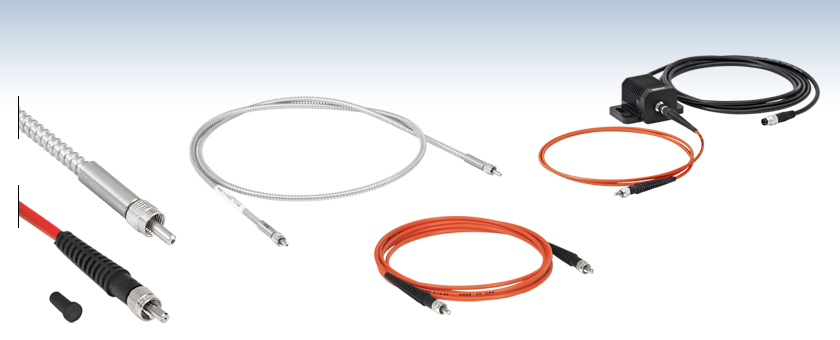
- Wide Variety of NAs and Core Sizes Available
- Available in Lengths up to 20 m
- Custom Cables Available with Same-Day Shipping
Application Idea
M65L02
SMA905 Connectors
on Both Ends
M28L01 Patch Cable
with M625F1 Fiber-Coupled
LED Light Source
M93L01

Please Wait
Applications
- Spectroscopy
- Illumination
- LED Energy Transmission
- Medical Instruments
- Optogenetics
Features
- Numerical Apertures from 0.100 to 0.50
- Cables Available for Wavelengths from 250 nm to 2400 nm
- Available in Lengths up to 20 m
- SMA905 Connectors on Both Ends
- Ø3 mm, Ø3.8 mm, or Ø5 mm Outer Jacket
- Custom Cables Available
Thorlabs offers multimode step index fiber optic patch cables with SMA905 (straight ferrule) connectors on both ends. These cables are ideal for a broad range of wavelengths from 250 nm to 2400 nm.
Each patch cable includes two protective caps that shield the connector ends from dust and other hazards. Additional CAPM Rubber Fiber Caps and CAPSM Metal Threaded Fiber Caps for SMA-terminated ends are also sold separately. All patch cables on this page are sold from stock with same-day shipping available.
The majority of the cables on this page have orange (Ø3 mm) or red (Ø3.8 mm) PVC furcation tubing, while the Ø1500 µm core fibers are packaged in stainless steel jackets. We recommend choosing stainless steel jackets when using fibers with large core diameters (≥Ø1000 µm) or high NAs (≥0.50) in light-sensitive applications, as it is easier for stray ambient light to penetrate the Ø3 mm (Item # FT030) and Ø3.8 mm (Item # FT038) fiber jackets. Alternatively, custom patch cables may be purchased that use our black or stainless steel furcation tubing (e.g., FT030-BK, FT038-BK, FT061PS, and others), in order to minimize stray light entering the fiber.
These cables are not designed for applications that require the fibers to carry high optical powers, as excessive powers can cause the epoxy used in the connectors to experience catastrophic heating. Please see the Damage Threshold tab for detailed information. Thorlabs offers alternate cabling options, in addition to unconnectorized fibers, that are compatible with high optical powers. Links to some options are included in the table below.
We have extensive patch cable capabilities including a large, diverse stock of optical fiber and many different types of fiber connectors. If you do not see a stock cable suitable for your application, please see our Custom Patch Cables webpage to request a cable that meets your specific needs.
| In-Stock Multimode Fiber Optic Patch Cable Selection Guide |
|---|
| Silica (180 nm to 2.4 µm) |
| Fluoride (285 nm to 5.5 µm) |
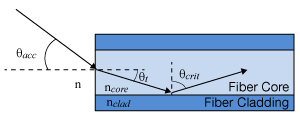
Click to Enlarge
Total Internal Reflection in an Optical Fiber
Guiding Light in an Optical Fiber
Optical fibers are part of a broader class of optical components known as waveguides that utilize total internal reflection (TIR) in order to confine and guide light within a solid or liquid structure. Optical fibers, in particular, are used in numerous applications; common examples include telecommunications, spectroscopy, illumination, and sensors.
One of the more common glass (silica) optical fibers uses a structure known as a step-index fiber, which is shown in the image to the right. Step-index fibers have an inner core made from a material with a refractive index that is higher than the surrounding cladding layer. Within the fiber, a critical angle of incidence exists such that light will reflect off the core/cladding interface rather than refract into the surrounding medium. To fulfill the conditions for TIR in the fiber, the angle of incidence of light launched into the fiber must be less than a certain angle, which is defined as the acceptance angle, θacc. Snell's law can be used to calculate this angle:
![]()

where ncore is the refractive index of the fiber core, nclad is the refractive index of the fiber cladding, n is the refractive index of the outside medium, θcrit is the critical angle, and θacc is the acceptance half-angle of the fiber. The numerical aperture (NA) is a dimensionless quantity used by fiber manufacturers to specify the acceptance angle of an optical fiber and is defined as:

In step-index fibers with a large core (multimode), the NA can be calculated directly using this equation. The NA can also be determined experimentally by tracing the far-field beam profile and measuring the angle between the center of the beam and the point at which the beam intensity is 5% of the maximum; however, calculating the NA directly provides the most accurate value.
Number of Modes in an Optical Fiber
Each potential path that light propagates through in an optical fiber is known as a guided mode of the fiber. Depending on the physical dimensions of the core/cladding regions, refractive index, and wavelength, anything from one to thousands of modes can be supported within a single optical fiber. The two most commonly manufactured variants are single mode fiber (which supports a single guided mode) and multimode fiber (which supports a large number of guided modes). In a multimode fiber, lower-order modes tend to confine light spatially in the core of the fiber; higher-order modes, on the other hand, tend to confine light spatially near the core/cladding interface.
Using a few simple calculations, it is possible to estimate the number of modes (single mode or multimode) supported by an optical fiber. The normalized optical frequency, also known as the V-number, is a dimensionless quantity that is proportional to the free space optical frequency but is normalized to guiding properties of an optical fiber. The V-number is defined as:
![]()
where V is the normalized frequency (V-number), a is the fiber core radius, and λ is the free space wavelength. Multimode fibers have very large V-numbers; for example, a Ø50 µm core, 0.39 NA multimode fiber at a wavelength of 1.5 µm has a V-number of 40.8.
For multimode fiber, which has a large V-number, the number of modes supported is approximated using the following relationship.
![]()
In the example above of the Ø50 µm core, 0.39 NA multimode fiber, it supports approximately 832 different guided modes that can all travel simultaneously through the fiber.
Single mode fibers are defined with a V-number cut-off of V < 2.405, which represents the point at which light is coupled only into the fiber's fundamental mode. To meet this condition, a single mode fiber has a much smaller core size and NA compared to a multimode fiber at the same wavelength. One example of this, SMF-28 Ultra single mode fiber, has a nominal NA of 0.14 and an Ø8.2 µm core at 1550 nm, which results in a V-number of 2.404.
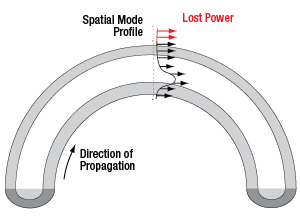
Click to Enlarge
Attenuation Due to Macrobend Loss
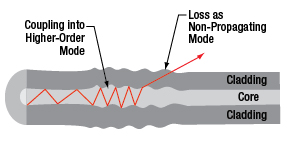
Click to Enlarge
Attenuation Due to Microbend Loss
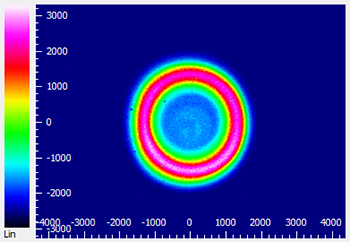
Click to Enlarge
Beam profile measurement of FT200EMT multimode fiber and a former generation M565F1 LED (replaced by the M565F3) showing light guided in the cladding rather than the core of the fiber.
Sources of Attenuation
Loss within an optical fiber, also referred to as attenuation, is characterized and quantified in order to predict the total transmitted power lost within a fiber optic setup. The sources of these losses are typically wavelength dependent and range from the material used in the fiber itself to bending of the fiber. Common sources of attenuation are detailed below:
Absorption
Because light in a standard optical fiber is guided via a solid material, there are losses due to absorption as light propagates through the fiber. Standard fibers are manufactured using fused silica and are optimized for transmission from 1300 nm to 1550 nm. At longer wavelengths (>2000 nm), multi-phonon interactions in fused silica cause significant absorption. Fluoride glasses such as ZrF4 and InF3 are used in manufacturing Mid-IR optical fibers primarily because they exhibit lower loss at these wavelengths. ZrF4 and InF3 fibers have a multi-phonon edge of ~3.6 µm and ~4.6 µm, respectively.
Contaminants in the fiber also contribute to the absorption loss. One example of an undesired impurity is water molecules that are trapped in the glass of the optical fiber, which will absorb light around 1300 nm and 2.94 µm. Since telecom signals and some lasers operate in that same region, any water molecules present in the fiber will attenuate the signal significantly.
The concentration of ions in the fiber glass is often controlled by manufacturers to tune the transmission/attenuation properties of a fiber. For example, hydroxyl ions (OH-) are naturally present in silica and absorb light in the NIR-IR spectrum. Therefore, fibers with low-OH content are preferred for transmission at telecom wavelengths. On the other hand, fibers with high-OH content typically exhibit increased transmission at UV wavelengths and thus may be preferred by users interested in applications such as fluorescence or UV-VIS spectroscopy.
Scattering
For the majority of fiber optics applications, light scattering is a source of loss that occurs when light encounters a change in the refractive index of the medium. These changes can be extrinsic, caused by impurities, particulates, or bubbles; or intrinsic, caused by fluctuations in the glass density, composition, or phase state. Scattering is inversely related to the wavelength of light, so scattering loss becomes significant at shorter wavelengths such as the UV or blue regions of the spectrum. Using proper fiber cleaning, handling, and storage procedures may minimize the presence of impurities on tips of fibers that cause large scattering losses.
Bending Loss
Losses that occur due to changes in the external and internal geometry of an optical fiber are known as bending loss. These are usually separated into two categories: macrobending loss and microbending loss.
Macrobend loss is typically associated with the physical bending of an optical fiber; for example, rolling it in a tight coil. As shown in the image to the right, guided light is spatially distributed within the core and cladding regions of the fiber. When a fiber is bent at a radius, light near the outer radius of the bend cannot maintain the same spatial mode profile without exceeding the speed of light. Instead, the energy is lost to the surroundings as radiation. For a large bend radius, the losses associated with bending are small; however, at bend radii smaller than the recommended bend radius of a fiber, bend losses become very significant. For short periods of time, optical fibers can be operated at a small bend radius; however, for long-term storage, the bend radius should be larger than the recommended value. Use proper storage conditions (temperature and bend radius) to reduce the likelihood of permanently damaging the fiber; the FSR1 Fiber Storage Reel is designed to minimize high bend loss.
Microbend loss arises from changes in the internal geometry of the fiber, particularly the core and cladding layers. These random variations (i.e., bumps) in the fiber structure disturb the conditions needed for total internal reflection, causing propagating light to couple into a non-propagating mode that leaks from the fiber (see the image to the right for details). Unlike macrobend loss, which is controlled by the bend radius, microbend loss occurs due to permanent defects in the fiber that are created during fiber manufacturing.
Cladding Modes
While most light in a multimode fiber is guided via TIR within the core of the fiber, higher-order modes that guide light within both the core and cladding layer, because of TIR at the cladding and coating/buffer interface, can also exist. This results in what is known as a cladding mode. An example of this can be seen in the beam profile measurement to the right, which shows cladding modes with a higher intensity in the cladding than in the core of the fiber. These modes can be non-propagating (i.e., they do not fulfill the conditions for TIR) or they can propagate over a significant length of fiber. Because cladding modes are typically higher-order, they are a source of loss in the presence of fiber bending and microbending defects. Cladding modes are also lost when connecting two fibers via connectors as they cannot be easily coupled between optical fibers.
Cladding modes may be undesired for some applications (e.g., launching into free space) because of their effect on the beam spatial profile. Over long fiber lengths, these modes will naturally attenuate. For short fiber lengths (<10 m), one method for removing cladding modes from a fiber is to use a mandrel wrap at a radius that removes cladding modes while keeping the desired propagating modes.
Launch Conditions
Underfilled Launch Condition
For a large multimode fiber which accepts light over a wide NA, the condition of the light (e.g., source type, beam diameter, NA) coupled into the fiber can have a significant effect on performance. An underfilled launch condition occurs when the beam diameter and NA of light at the coupling interface are smaller than the core diameter and NA of the fiber. A common example of this is launching a laser source into a large multimode fiber. As seen in the diagram and beam profile measurement below, underfilled launches tend to concentrate light spatially in the center of the fiber, filling lower-order modes preferentially over higher-order modes. As a result, they are less sensitive to macrobend losses and do not have cladding modes. The measured insertion loss for an underfilled launch tends to be lower than typical, with a higher power density in the core of the fiber.
Overfilled Launch Condition
Overfilled launches are defined by situations where the beam diameter and NA at the coupling interface are larger than the core diameter and NA of the fiber. One method to achieve this is by launching light from an LED source into a small multimode fiber. An overfilled launch completely exposes the fiber core and some of the cladding to light, enabling the filling of lower- and higher-order modes equally (as seen in the images below) and increasing the likelihood of coupling into cladding modes of the fiber. This increased percentage of higher-order modes means that overfilled fibers are more sensitive to bending loss. The measured insertion loss for an overfilled launch tends to be higher than typical, but results in an overall higher output power compared to an underfilled fiber launch.
There are advantages and disadvantages to underfilled or overfilled launch conditions, depending on the needs of the intended application. For measuring the baseline performance of a multimode fiber, Thorlabs recommends using a launch condition where the beam diameter is 70-80% of the fiber core diameter. Over short distances, an overfilled fiber has more output power; however, over long distances (>10 - 20 m) the higher-order modes that more susceptible to attenuation will disappear.
| Quick Links |
|---|
| Damage at the Air / Glass Interface |
| Intrinsic Damage Threshold |
| Preparation and Handling of Optical Fibers |
Laser-Induced Damage in Silica Optical Fibers
The following tutorial details damage mechanisms relevant to unterminated (bare) fiber, terminated optical fiber, and other fiber components from laser light sources. These mechanisms include damage that occurs at the air / glass interface (when free-space coupling or when using connectors) and in the optical fiber itself. A fiber component, such as a bare fiber, patch cable, or fused coupler, may have multiple potential avenues for damage (e.g., connectors, fiber end faces, and the device itself). The maximum power that a fiber can handle will always be limited by the lowest limit of any of these damage mechanisms.
While the damage threshold can be estimated using scaling relations and general rules, absolute damage thresholds in optical fibers are very application dependent and user specific. Users can use this guide to estimate a safe power level that minimizes the risk of damage. Following all appropriate preparation and handling guidelines, users should be able to operate a fiber component up to the specified maximum power level; if no maximum is specified for a component, users should abide by the "practical safe level" described below for safe operation of the component. Factors that can reduce power handling and cause damage to a fiber component include, but are not limited to, misalignment during fiber coupling, contamination of the fiber end face, or imperfections in the fiber itself. For further discussion about an optical fiber’s power handling abilities for a specific application, please contact Thorlabs’ Tech Support.

Click to Enlarge
Undamaged Fiber End

Click to Enlarge
Damaged Fiber End
Damage at the Air / Glass Interface
There are several potential damage mechanisms that can occur at the air / glass interface. Light is incident on this interface when free-space coupling or when two fibers are mated using optical connectors. High-intensity light can damage the end face leading to reduced power handling and permanent damage to the fiber. For fibers terminated with optical connectors where the connectors are fixed to the fiber ends using epoxy, the heat generated by high-intensity light can burn the epoxy and leave residues on the fiber facet directly in the beam path.
| Estimated Optical Power Densities on Air / Glass Interfacea | ||
|---|---|---|
| Type | Theoretical Damage Thresholdb | Practical Safe Levelc |
| CW (Average Power) |
~1 MW/cm2 | ~250 kW/cm2 |
| 10 ns Pulsed (Peak Power) |
~5 GW/cm2 | ~1 GW/cm2 |
Damage Mechanisms on the Bare Fiber End Face
Damage mechanisms on a fiber end face can be modeled similarly to bulk optics, and industry-standard damage thresholds for UV Fused Silica substrates can be applied to silica-based fiber. However, unlike bulk optics, the relevant surface areas and beam diameters involved at the air / glass interface of an optical fiber are very small, particularly for coupling into single mode (SM) fiber. therefore, for a given power density, the power incident on the fiber needs to be lower for a smaller beam diameter.
The table to the right lists two thresholds for optical power densities: a theoretical damage threshold and a "practical safe level". In general, the theoretical damage threshold represents the estimated maximum power density that can be incident on the fiber end face without risking damage with very good fiber end face and coupling conditions. The "practical safe level" power density represents minimal risk of fiber damage. Operating a fiber or component beyond the practical safe level is possible, but users must follow the appropriate handling instructions and verify performance at low powers prior to use.
Calculating the Effective Area for Single Mode Fibers
The effective area for single mode (SM) fiber is defined by the mode field diameter (MFD), which is the cross-sectional area through which light propagates in the fiber; this area includes the fiber core and also a portion of the cladding. To achieve good efficiency when coupling into a single mode fiber, the diameter of the input beam must match the MFD of the fiber.
As an example, SM400 single mode fiber has a mode field diameter (MFD) of ~Ø3 µm operating at 400 nm, while the MFD for SMF-28 Ultra single mode fiber operating at 1550 nm is Ø10.5 µm. The effective area for these fibers can be calculated as follows:
SM400 Fiber: Area = Pi x (MFD/2)2 = Pi x (1.5 µm)2 = 7.07 µm2 = 7.07 x 10-8 cm2
SMF-28 Ultra Fiber: Area = Pi x (MFD/2)2 = Pi x (5.25 µm)2 = 86.6 µm2 = 8.66 x 10-7 cm2
To estimate the power level that a fiber facet can handle, the power density is multiplied by the effective area. Please note that this calculation assumes a uniform intensity profile, but most laser beams exhibit a Gaussian-like shape within single mode fiber, resulting in a higher power density at the center of the beam compared to the edges. Therefore, these calculations will slightly overestimate the power corresponding to the damage threshold or the practical safe level. Using the estimated power densities assuming a CW light source, we can determine the corresponding power levels as:
SM400 Fiber: 7.07 x 10-8 cm2 x 1 MW/cm2 = 7.1 x 10-8 MW = 71 mW (Theoretical Damage Threshold)
7.07 x 10-8 cm2 x 250 kW/cm2 = 1.8 x 10-5 kW = 18 mW (Practical Safe Level)
SMF-28 Ultra Fiber: 8.66 x 10-7 cm2 x 1 MW/cm2 = 8.7 x 10-7 MW = 870 mW (Theoretical Damage Threshold)
8.66 x 10-7 cm2 x 250 kW/cm2 = 2.1 x 10-4 kW = 210 mW (Practical Safe Level)
Effective Area of Multimode Fibers
The effective area of a multimode (MM) fiber is defined by the core diameter, which is typically far larger than the MFD of an SM fiber. For optimal coupling, Thorlabs recommends focusing a beam to a spot roughly 70 - 80% of the core diameter. The larger effective area of MM fibers lowers the power density on the fiber end face, allowing higher optical powers (typically on the order of kilowatts) to be coupled into multimode fiber without damage.
Damage Mechanisms Related to Ferrule / Connector Termination
 Click to Enlarge
Click to EnlargePlot showing approximate input power that can be incident on a single mode silica optical fiber with a termination. Each line shows the estimated power level due to a specific damage mechanism. The maximum power handling is limited by the lowest power level from all relevant damage mechanisms (indicated by a solid line).
Fibers terminated with optical connectors have additional power handling considerations. Fiber is typically terminated using epoxy to bond the fiber to a ceramic or steel ferrule. When light is coupled into the fiber through a connector, light that does not enter the core and propagate down the fiber is scattered into the outer layers of the fiber, into the ferrule, and the epoxy used to hold the fiber in the ferrule. If the light is intense enough, it can burn the epoxy, causing it to vaporize and deposit a residue on the face of the connector. This results in localized absorption sites on the fiber end face that reduce coupling efficiency and increase scattering, causing further damage.
For several reasons, epoxy-related damage is dependent on the wavelength. In general, light scatters more strongly at short wavelengths than at longer wavelengths. Misalignment when coupling is also more likely due to the small MFD of short-wavelength SM fiber that also produces more scattered light.
To minimize the risk of burning the epoxy, fiber connectors can be constructed to have an epoxy-free air gap between the optical fiber and ferrule near the fiber end face. Our high-power multimode fiber patch cables use connectors with this design feature.
Determining Power Handling with Multiple Damage Mechanisms
When fiber cables or components have multiple avenues for damage (e.g., fiber patch cables), the maximum power handling is always limited by the lowest damage threshold that is relevant to the fiber component. In general, this represents the highest input power that can be incident on the patch cable end face and not the coupled output power.
As an illustrative example, the graph to the right shows an estimate of the power handling limitations of a single mode fiber patch cable due to damage to the fiber end face and damage via an optical connector. The total input power handling of a terminated fiber at a given wavelength is limited by the lower of the two limitations at any given wavelength (indicated by the solid lines). A single mode fiber operating at around 488 nm is primarily limited by damage to the fiber end face (blue solid line), but fibers operating at 1550 nm are limited by damage to the optical connector (red solid line).
In the case of a multimode fiber, the effective mode area is defined by the core diameter, which is larger than the effective mode area for SM fiber. This results in a lower power density on the fiber end face and allows higher optical powers (on the order of kilowatts) to be coupled into the fiber without damage (not shown in graph). However, the damage limit of the ferrule / connector termination remains unchanged and as a result, the maximum power handling for a multimode fiber is limited by the ferrule and connector termination.
Please note that these are rough estimates of power levels where damage is very unlikely with proper handling and alignment procedures. It is worth noting that optical fibers are frequently used at power levels above those described here. However, these applications typically require expert users and testing at lower powers first to minimize risk of damage. Even still, optical fiber components should be considered a consumable lab supply if used at high power levels.
Intrinsic Damage Threshold
In addition to damage mechanisms at the air / glass interface, optical fibers also display power handling limitations due to damage mechanisms within the optical fiber itself. These limitations will affect all fiber components as they are intrinsic to the fiber itself. Two categories of damage within the fiber are damage from bend losses and damage from photodarkening.
Bend Losses
Bend losses occur when a fiber is bent to a point where light traveling in the core is incident on the core/cladding interface at an angle higher than the critical angle, making total internal reflection impossible. Under these circumstances, light escapes the fiber, often in a localized area. The light escaping the fiber typically has a high power density, which burns the fiber coating as well as any surrounding furcation tubing.
A special category of optical fiber, called double-clad fiber, can reduce the risk of bend-loss damage by allowing the fiber’s cladding (2nd layer) to also function as a waveguide in addition to the core. By making the critical angle of the cladding/coating interface higher than the critical angle of the core/clad interface, light that escapes the core is loosely confined within the cladding. It will then leak out over a distance of centimeters or meters instead of at one localized spot within the fiber, minimizing the risk of damage. Thorlabs manufactures and sells 0.22 NA double-clad multimode fiber, which boasts very high, megawatt range power handling.
Photodarkening
A second damage mechanism, called photodarkening or solarization, can occur in fibers used with ultraviolet or short-wavelength visible light, particularly those with germanium-doped cores. Fibers used at these wavelengths will experience increased attenuation over time. The mechanism that causes photodarkening is largely unknown, but several fiber designs have been developed to mitigate it. For example, fibers with a very low hydroxyl ion (OH) content have been found to resist photodarkening and using other dopants, such as fluorine, can also reduce photodarkening.
Even with the above strategies in place, all fibers eventually experience photodarkening when used with UV or short-wavelength light, and thus, fibers used at these wavelengths should be considered consumables.
Preparation and Handling of Optical Fibers
General Cleaning and Operation Guidelines
These general cleaning and operation guidelines are recommended for all fiber optic products. Users should still follow specific guidelines for an individual product as outlined in the support documentation or manual. Damage threshold calculations only apply when all appropriate cleaning and handling procedures are followed.
-
All light sources should be turned off prior to installing or integrating optical fibers (terminated or bare). This ensures that focused beams of light are not incident on fragile parts of the connector or fiber, which can possibly cause damage.
-
The power-handling capability of an optical fiber is directly linked to the quality of the fiber/connector end face. Always inspect the fiber end prior to connecting the fiber to an optical system. The fiber end face should be clean and clear of dirt and other contaminants that can cause scattering of coupled light. Bare fiber should be cleaved prior to use and users should inspect the fiber end to ensure a good quality cleave is achieved.
-
If an optical fiber is to be spliced into the optical system, users should first verify that the splice is of good quality at a low optical power prior to high-power use. Poor splice quality may increase light scattering at the splice interface, which can be a source of fiber damage.
-
Users should use low power when aligning the system and optimizing coupling; this minimizes exposure of other parts of the fiber (other than the core) to light. Damage from scattered light can occur if a high power beam is focused on the cladding, coating, or connector.
Tips for Using Fiber at Higher Optical Power
Optical fibers and fiber components should generally be operated within safe power level limits, but under ideal conditions (very good optical alignment and very clean optical end faces), the power handling of a fiber component may be increased. Users must verify the performance and stability of a fiber component within their system prior to increasing input or output power and follow all necessary safety and operation instructions. The tips below are useful suggestions when considering increasing optical power in an optical fiber or component.
-
Splicing a fiber component into a system using a fiber splicer can increase power handling as it minimizes possibility of air/fiber interface damage. Users should follow all appropriate guidelines to prepare and make a high-quality fiber splice. Poor splices can lead to scattering or regions of highly localized heat at the splice interface that can damage the fiber.
-
After connecting the fiber or component, the system should be tested and aligned using a light source at low power. The system power can be ramped up slowly to the desired output power while periodically verifying all components are properly aligned and that coupling efficiency is not changing with respect to optical launch power.
-
Bend losses that result from sharply bending a fiber can cause light to leak from the fiber in the stressed area. When operating at high power, the localized heating that can occur when a large amount of light escapes a small localized area (the stressed region) can damage the fiber. Avoid disturbing or accidently bending fibers during operation to minimize bend losses.
-
Users should always choose the appropriate optical fiber for a given application. For example, large-mode-area fibers are a good alternative to standard single mode fibers in high-power applications as they provide good beam quality with a larger MFD, decreasing the power density on the air/fiber interface.
-
Step-index silica single mode fibers are normally not used for ultraviolet light or high-peak-power pulsed applications due to the high spatial power densities associated with these applications.
Thorlabs Lab Facts: Modifying Beam Profiles with Multimode Fibers
We present laboratory measurements demonstrating how the output beam profile from multimode fiber can be affected by the beam entry angle. In some applications, an alternative beam distribution such as a top hat or donut is desired instead of the inherent Gaussian distribution provided by typical optics. Here we investigated the effect of changing the input angle of a focused laser beam into a multimode fiber patch cable. Focusing the light normal to the fiber face produced a near-Gaussian output beam profile (Figure 1) and increasing the angle resulted in top hat- (Figure 2) and donut-shaped (Figure 3) beam profiles. These results demonstrate how multimode fibers can be used to change the shape of a beam profile.
For our experiment, we used an M38L01 Ø200 µm, 0.39 NA, Step-Index Fiber Patch Cable (Bare Fiber Item # FT200EMT) as the test fiber into which we launched the focused laser beam. The input light was set incident at 0°, 11°, and 15° to the input face of the multimode fiber to create the initial, top hat, and donut profiles, respectively. Each time the angle was changed, the alignment of the input fiber was optimized while the output power was monitored with a power meter to ensure maximum coupling was achieved. Images were then acquired with a 9 second exposure and the shape of the beam profile was evaluated. Note that during the exposure, a 1500 grit diffuser was manually rotated between the coupling optics (before the fiber under test) to reduce the spatial coherence and create a clean output beam profile.
Assuming a ray tracing model, there are two general types of rays that propagate along a multimode fiber: (a) meridional rays, which pass through the central axis of the fiber after each reflection, and (b) skew rays, which never pass through the central axis of the fiber. The figures below illustrate the three basic ray propagation scenarios observed during the experiment. Figures 4 and 6 depict meridional and skew ray propagation through multimode fiber, respectively, and the associated theoretical beam distribution at the fiber output. As illustrated in Figure 6, skew rays propagate in a helical path along the fiber that is tangent to the inner caustic of the path with radius r. Figure 5 depicts the beam propagation and beam distribution from a combination of meridional and skew rays. By changing the input angle of the light launched into a multimode fiber, we were able to modify the proportion of light rays propagating as meridional rays vs. skew rays, and consequently, modify the output from a near-Gaussian distribution (primarily meridional rays, see Figure 1) to a top hat (mixture of meridional and skew rays, see Figure 2) to a donut (primarily skew rays, see Figure 3). The beam profiles shown in Figures 4 through 6 were obtained at a distance of 5 mm from the fiber end face. These results demonstrate the ability to use a standard multimode fiber patch cable as a relatively inexpensive method to modify an input Gaussian profile into a top hat and donut profile with minimal loss. For details on the experimental setup employed and these summarized results, please click here.
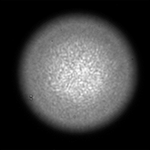
Figure 1. Near-Gaussian Beam Profile
Obtained at 0° Input Angle (Normal to Fiber Face)
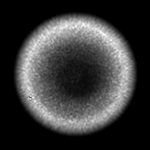
Figure 3. Donut Beam Profile
Obtained at 15° Input Angle
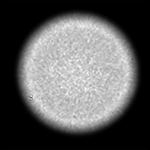
Figure 2. Top Hat Beam Profile
Obtained at 11° Input Angle
| Posted Comments: | |
user
(posted 2024-03-07 13:06:42.22) Hello,
I would like to know what is the temperature range of the M59L01 fiber?
Thanks in advance jpolaris
(posted 2024-03-11 04:29:19.0) Thank you for contacting Thorlabs. The limiting factor in the operating temperature range of our M59L01 patch cable is actually the red PVC tubing (part number FT038), which has an operating temperature range of -20 °C - 70 °C. M59L01 is comprised of our FP1000ERT fiber inside of the FT038 tubing, with SMA connectors epoxied on the ends using 353NDPK. The glass transition temperature of 353NDPK is > 90 °C, and the operating temperature of FP1000ERT itself is -40 °C - 85 °C. So, if you purchase M59L01, be sure to operate it within -20 °C - 70 °C. user
(posted 2023-11-24 15:53:13.513) Hello,
Is the SMA905 connectors' bore diameter designed to be the same as the fiber's diameter?
Also, is the connector's bore made of any material or just filled with air?
Thank you cdolbashian
(posted 2023-11-29 04:07:44.0) Thank you for reaching out to us with this inquiry. The bore size is sized to fit the core and cladding diameters. You should strip away the coating and buffer layers with the appropriate stripping tool. The bore is a hole drilled through the solid SMA connector. In this sense it is filled with air until the fiber is terminated within it. As you have not provided an email, I cannot reach out to you to clarify these questions. Dave Hofeldt
(posted 2021-10-12 08:43:38.277) You should NOT specify this fiber as an 0.22 NA fiber. It is a double clad fiber, and if you overfill it in both angle and core dimensions, as is usually the recommended method for getting uniform mode filling out of a multimode fiber, you will get 0.39 NA output. I realize if you look up the fiber that will be clear, but no one does that when all they see is 0.22 NA spec. azandani
(posted 2021-10-12 03:38:05.0) Hello Dave, thank you for contacting Thorlabs. I am sorry for the confusion for the marketing of this product and we will update our web presentation to be more clear. I see you are already in contact with our team regarding this and we will continue our correspondence. Yoon Jang
(posted 2021-03-11 11:57:52.863) Could I get the raw transmission loss data(excel) of M107L02 ? YLohia
(posted 2021-03-12 03:39:19.0) The attenuation data can be converted to transmission data using the following calculation: 10^(-[insert dB/meter spec here]/10) * 100[to convert to %] = %/m JI XUANXUAN
(posted 2020-10-06 01:51:49.073) 您好,这个型号的光纤的Ncore=?,Nclab=? YLohia
(posted 2020-10-06 10:27:25.0) Hello, refractive index information is given on the component fiber page: https://www.thorlabs.us/newgrouppage9.cfm?objectgroup_id=362&tabname=Specs Igor Bel'bas
(posted 2019-12-03 11:40:12.927) Fiber bundle L about 10 m, in/out diameter about or less then 8mm NA about 1
Second fiber bundle lenght 10 m in/out diameter about or less 8mm NA = 0.2
p.s.NA aimed use minimal interf.filter (1/2") diameter arter collimation of 1 nm fwhm and 10 nm fwhm
Multimode, glued close packing, low power visible light,
price, terms of purchase in Russia? llamb
(posted 2019-12-03 03:39:33.0) Thank you for contacting Thorlabs. Please use the "Request a Quote" button or email TechSupport@thorlabs.com if you are interested in a custom fiber quote. We have reached out to you directly in this case. thomas.dalby
(posted 2017-07-04 15:00:19.79) Can you please provide the "raw data" (in Excel spreadsheet form) for the transmission response of part number M28L05? Thanks nbayconich
(posted 2017-07-11 09:37:17.0) Thank you for contacting Thorlabs. I will contact you directly with the raw transmission loss data for the M28L05. user
(posted 2014-10-08 14:59:30.733) What is the proof test of the fiber utilized for the M25L01 patch cable? jlow
(posted 2014-10-09 08:14:03.0) Response from Jeremy at Thorlabs: The fiber used in the patch cable is Thorlabs' FG200LCC, which is proof-tested at 100kpsi. schaefer
(posted 2013-09-05 15:22:02.703) Do you have scrambling factors for any of your available fibers measured? pbui
(posted 2013-09-06 17:59:00.0) Response from Phong at Thorlabs: Thank you for your post. Unfortunately, we are not setup to perform this type of test, so we don't have any information to share regarding the scrambling factors. jlow
(posted 2012-10-26 13:24:00.0) Response from Jeremy at Thorlabs: In general, it is good practice to look at the end face of the connector with a fiberscope before using it and clean it if necessary. This would make sure that the connector end face is clean before being used. rpsmith
(posted 2012-10-26 13:07:18.99) Hello,
I currently have the M15L05, and I am wondering about the cleaning procedure. Should one periodically clean the connectors with the hand-held connector cleaner (FCC-7020)? Or is it unnecessary to clean since the fiber has metal tips?
Sincerely,
Ryan tcohen
(posted 2012-07-12 15:03:00.0) Response from Tim at Thorlabs: When coupling into multimode fiber, you should make sure that the focused spot is comparable or smaller to the core size and that the incident angle is not larger than the acceptance angle of the fiber. Both of these factors should be considered for best efficiency and can be calculated based on the source and focusing lens you are using. I will contact you to discuss these parameters within your equipment. paul.lauria
(posted 2012-07-11 19:53:26.0) We're collecting a Raman signal using one of your collimators and are wondering about appropriate core diameters for fibers.
One would assume the larger the diameter, greater collection efficiency at the cost of greater divergence at spectrometer end, but all the formulae I've seen involve the NA only. bdada
(posted 2012-02-08 19:00:00.0) Response from Buki at Thorlabs to renfang:
The M24L01 patch cable uses the BFL22-200 fiber, which is designed for 350nm to 2500nm. The specification sheet is linked below and it includes attenuation curves for the wavelength range:
http://www.thorlabs.com/Thorcat/12200/12239-S01.pdf
Please note that the M24L01 has been replaced by M25L01, which uses a different fiber, FG200LCC. If you want to continue using the current patch cord you have, we can still provide it for you as a custom patch cord.
Please contact TechSupport@thorlabs.com if you have any questions. renfang
(posted 2012-02-08 16:50:22.0) Multimode fiber is very useful in some experiments. Now I'm using the multimode fiber(50 µm, 0.22 NA, SMA-SMA Fiber Patch Cable, 1 Meter) in my experiment.
Could you tell me the transmittance of multimode fiber M24L01 at the wavelength 380nm-390nm?
Thank you very much. jjurado
(posted 2011-08-04 13:26:00.0) Response from Javier at Thorlabs to last poster: Thank you very much for your feedback! We will implement your idea shortly. The core size and NA information will be printed on the jacket of our fiber patch cables. Please contact us at techsupport@thorlabs.com if you have any further questions. user
(posted 2011-08-03 17:26:19.0) It would be nice to have the core size and NA printed on the cables. bdada
(posted 2011-06-06 19:39:00.0) Response from Buki at Thorlabs:
Thank you for using our Feedback Tool. To transmit 8W, please consider our high power SMA patch cables linked below and note that the core sizes available are 200um, 365um, and 550um.
http://www.thorlabs.com/NewGroupPage9.cfm?ObjectGroup_ID=4393
If you have further questions about this, please contact TechSupport@thorlabs.com leonard.migliore
(posted 2011-06-06 11:48:06.0) How much power can the M15L02 tolerate? I need to transmit 8 W CW at 532 nm. jjurado
(posted 2011-05-23 13:35:00.0) Response from Javier at Thorlabs to schaefer: Thank you very much for contacting us. If you plan to use the RC08SMA-P01, you could also use our HPSC25 fiber, which has a numerical aperture of 0.100 (± 0.015) and a core size of 25 um: http://www.thorlabs.com/NewGroupPage9.cfm?ObjectGroup_ID=3255.
We can connectorize this fiber with SMA connectors to virtually any desired length. I will contact you directly for further support. schaefer
(posted 2011-05-23 10:56:38.0) I want to couple light from a polychromatic lightsource (a halogen lamp) into a multimode fiber and need a highly collimated output from that fiber. I assume your reflective collimators (RC04SMA-P01 & RC08SMA-P01) are what Im looking for. However, you state that for the RC08SMA-P01, which would have the lowest divergence, I need a multimode fiber with NA less than 0.167 but I cant find such a fiber on this page. Since divergence = arctan (Core Diameter in mm / EFL in mm) I would prefer to use a 50µm fiber (coupling efficiency isnt a big issue). Adam
(posted 2010-03-31 17:02:12.0) A response from Adam at Thorlabs to jonne: Damage thresholds are rather tough to provide as they depend heavily on initial conditions. The damage threshold of 5.4J/mm^2 for the .22NA fibers would be the same values for the .37NA(FT600EMT) and the .48NA(BFL48-600) fibers. Please note that this value is only valid if you are filling ~400-500um of the core. If you are filling the full 600um, you may damage some of the hard cladding. jonne.haapalainen
(posted 2010-03-31 10:27:46.0) Which of the 600µm (or 550µm) fibers has highest damage treshold (for ca. 1ns pulse)? NA 0.22 seems to be the only one which has specs for it. apalmentieri
(posted 2010-02-17 09:04:33.0) A response from Adam at Thorlabs to mth: We can provide AR coatings on the facets. We would need more information before we provide you with a quote. I will contact you directly to get this information. mth
(posted 2010-02-17 06:44:34.0) Can you do AR coatings (on facets) on these fibres for custom cables? klee
(posted 2009-10-20 10:49:32.0) A response from Ken at Thorlabs to s0793799: Please click on the Specs tab for specifications. For more information on the fibers used, you can click on the fiber part numbers in the Specs tab. The cables have polished ends, not cleaved ends. s0793799
(posted 2009-10-20 05:14:49.0) Specification catalogue is not available. How are the fibe cleaved? Tyler
(posted 2008-12-26 08:15:23.0) A response from Tyler at Thorlabs to omikrongr: The Numerical Aperture (NA) is a unitless number that is equal to the sine of the divergence angle. So a NA of 0.22 corresponds to a divergence angle of 12.7 degrees. For the remainder of your questions I am going to have a technical support team member contact you to discuss your application. omikrongr
(posted 2008-12-25 15:35:18.0) We have a DPSS laser of 95W at 980nm output and a DPSS laser of 40W output at 808nm.
Both of the have SMA connectors for the output.
We plan to use M14L05 to transfer the beam and take an output high power concentrated laser beam of 50um diameter at the end SMA connector.
We do not know much of fiber optics.
We assume that 0.22NA are in degrees.
Can you confirm us how long will the beam diameter be in a distance of 10mm?
What will be the losses in each one of the above applications? (How many Watts output will have on both applications)
Thank you in advance for your help. Laurie
(posted 2008-12-16 16:14:59.0) Response from Laurie at Thorlabs to anita_tzeng: These fibers can easily work down to vacuum levels around 1 x 10^-3 Torr. For vacuum levels in the 10^-5 or 10^-6 Torr range, these stock fibers are not suitable due to the jacketing and epoxy used. As a custom item, the jacketing can be changed to stainless steel and vacuum-compatible epoxy can be used. Please contact our technical support staff if you would like to pursue this avenue. anita_tzeng
(posted 2008-12-16 00:10:21.0) Please advise if this item could use under vacuity? Laurie
(posted 2008-04-16 09:02:06.0) Response from Laurie at Thorlabs to hongwei: Thank you for your interest in our products. I have passed your inquiry on to our technical support staff. You will be contacted shortly by an applications engineer who will work with you to determine the best solution for your application. hongwei
(posted 2008-04-14 18:01:55.0) Would you please recomend a collimator lens? I found some lens such as F240SMA-A. However, the NA doesnot fit. Furthermore, we are working at a broadrange from 400nm to 2000nm. Can you provide uncoated lens collimor? technicalmarketing
(posted 2007-11-01 14:27:42.0) Our web team has corrected the issue concerning which tab shows when you load the page. You should now view the overview tab when you first enter a page. cjohns
(posted 2007-10-29 13:44:24.0) When page is loaded, it brings up presentation feedback tab; not overview. technicalmarketing
(posted 2007-10-08 08:21:07.0) The M25L05 patch cable is 5 meters of BFL22-200 multimode fiber terminated on both ends with SMA connectors. So it is unnecessary to purchase the cable separately. Thank you for your feedback. pierre
(posted 2007-10-08 08:08:16.0) If I order want to M25L05, do I need to order BFL22-200 separately? |

| Item # Prefix |
Fiber | Core Diameter |
NA | Cladding Diameter |
Coating Diameter |
Short-Term Bend Radiusa |
Long-Term Bend Radiusa |
Wavelength Range | Attenuation Plot | Jacket |
|---|---|---|---|---|---|---|---|---|---|---|
| M65L | FG010LDA | 10 ± 3 µm | 0.100 ± 0.015 | 125 ± 2 µm | 245 ± 10 µm | 16 mm | 32 mm | 400 - 550 nm and 700 - 1000 nm | Ø3 mm Orange PVC Furcation Tubing |

| Item # Prefix |
Fiber | Core Diameter |
NA | Cladding Diameter |
Coating Diameter |
Short-Term Bend Radiusa |
Long-Term Bend Radiusa |
Wavelength Range | Attenuation Plot | Jacket |
|---|---|---|---|---|---|---|---|---|---|---|
| M68L | FG025LJA | 25 ± 3 µm | 0.100 ± 0.015 | 125 ± 2 µm | 245 ± 10 µm | 16 mm | 32 mm | 400 - 550 nm and 700 - 1400 nm | Ø3 mm Orange PVC Furcation Tubing |

| Item # Prefix |
Fiber | Core Diameter |
NA | Cladding Diameter |
Coating Diameter |
Short-Term Bend Radiusa |
Long-Term Bend Radiusa |
Wavelength Range | Attenuation Plot | Jacket |
|---|---|---|---|---|---|---|---|---|---|---|
| M14L | FG050LGA | 50 µm ± 1 µm | 0.22 ± 0.02 | 125 +1/-2 µm | 250 ± 10 µm | 16 mm | 32 mm | 400 to 2400 nm (Low OH) |
Ø3 mm Orange PVC Furcation Tubing |

| Item # Prefix |
Fiber | Core Diameter |
NA | Cladding Diameter |
Coating Diameter |
Short-Term Bend Radiusa |
Long-Term Bend Radiusa |
Wavelength Range | Attenuation Plot | Jacket |
|---|---|---|---|---|---|---|---|---|---|---|
| M96L | FG105LVA | 105 ± 3 µm | 0.100 ± 0.015 | 125 ± 2 µm | 250 ± 10 µm | 16 mm | 32 mm | 400 - 2100 nm | Ø3 mm Orange PVC Furcation Tubing |

| Item # Prefix |
Fiber | Core Diameter |
NA | Cladding Diameter |
Coating Diameter |
Short-Term Bend Radiusa |
Long-Term Bend Radiusa |
Wavelength Range | Attenuation Plot | Jacket |
|---|---|---|---|---|---|---|---|---|---|---|
| M15L | FG105LCA | 105 +1/-3 µm | 0.22 ± 0.02 | 125 +1/-2 µm | 250 ± 10 μm | 16 mm | 32 mm | 400 to 2400 nm (Low OH) |
Ø3 mm Orange PVC Furcation Tubing |

| Item # Prefix |
Fiber | Core Diameter |
NA | Cladding Diameter |
Coating Diameter |
Buffer Diameter |
Short-Term Bend Radiusa |
Long-Term Bend Radiusa |
Wavelength Range | Attenuation Plot |
Jacket |
|---|---|---|---|---|---|---|---|---|---|---|---|
| M92L | FG200UEA | 200 ± 4 µm | 0.22 ± 0.02 | 220 ± 2 µm | 320 ± 16 µm | N/A | 23 mm | 46 mm | 250 - 1200 nm (High OH) |
Ø3 mm Orange PVC Furcation Tubing |
|
| M151L | FG200UCC | 200 ± 8 µm | 0.22 ± 0.02 | 240 ± 5 µm | 260 ± 6 µmb | 400 ± 30 µm | 26 mm | 52 mm | 250 - 1200 nm (High OH) |
Ø3 mm Orange PVC Furcation Tubing |

| Item # Prefix |
Fiber | Core Diameter |
NA | Cladding Diameter |
Coating Diameter |
Short-Term Bend Radiusa |
Long-Term Bend Radiusa |
Wavelength Range | Attenuation Plot | Jacket |
|---|---|---|---|---|---|---|---|---|---|---|
| M25L | FG200LCC | 200 ± 8 µm | 0.22 ± 0.02 | 240 ± 5 µm | 260 ± 6 µm | 26 mm | 52 mm | 400 to 2200 nm (Low OH) |
Ø3 mm Orange PVC Furcation Tubing |

| Item # Prefix |
Fiber | Core Diameter |
NA | Cladding Diameter |
Coating Diameter |
Short-Term Bend Radiusa |
Long-Term Bend Radiusa |
Wavelength Range | Attenuation Plot | Jacket |
|---|---|---|---|---|---|---|---|---|---|---|
| M38L | FT200EMT | 200 ± 5 µm | 0.39 | 225 ± 5 µm | 500 ± 30 µm | 21 mm | 42 mm | 400 to 2200 nm (Low OH) |
Ø3 mm Orange PVC Furcation Tubing |

| Item # Prefix |
Fiber | Core Diameter |
NA | Cladding Diameter |
Coating Diameter |
Short-Term Bend Radiusa |
Long-Term Bend Radiusa |
Wavelength Range | Attenuation Plot | Jacket |
|---|---|---|---|---|---|---|---|---|---|---|
| M44L | FP200ERT | 200 ± 5 µm | 0.50 | 225 ± 5 µm | 500 ± 30 µm | 21 mm | 42 mm | 400 to 2200 nm (Low OH) |
Ø3 mm Orange PVC Furcation Tubing |

| Item # Prefix |
Fiber | Core Diameter |
NA | Cladding Diameter |
Coating Diameter |
Short-Term Bend Radiusa |
Long-Term Bend Radiusa |
Wavelength Range | Attenuation Plot | Jacket |
|---|---|---|---|---|---|---|---|---|---|---|
| M152L | FG400LEA | 400 ± 8 µm | 0.22 ± 0.02 | 440 ± 4 µm | 550 ± 15 µm | 47 mm | 94 mm | 400 to 2400 nm (Low OH) |
Ø3 mm Orange PVC Furcation Tubing |

| Item # Prefix |
Fiber | Core Diameter |
NA | Cladding Diameter |
Coating Diameter |
Short-Term Bend Radiusa |
Long-Term Bend Radiusa |
Wavelength Range | Attenuation Plot | Jacket |
|---|---|---|---|---|---|---|---|---|---|---|
| M28L | FT400EMT | 400 ± 8 µm | 0.39 | 425 ± 10 µm | 730 ± 30 µm | 43 mm | 86 mm | 400 to 2200 nm (Low OH) |
Ø3 mm Orange PVC Furcation Tubing |

| Item # Prefix |
Fiber | Core Diameter |
NA | Cladding Diameter |
Coating Diameter |
Short-Term Bend Radiusa |
Long-Term Bend Radiusa |
Wavelength Range | Attenuation Plot | Jacket |
|---|---|---|---|---|---|---|---|---|---|---|
| M45L | FP400ERT | 400 ± 8 µm | 0.50 | 425 ± 10 µm | 730 ± 30 µm | 43 mm | 86 mm | 400 to 2200 nm (Low OH) |
Ø3 mm Orange PVC Furcation Tubing |

| Item # Prefix |
Fiber | Core Diameter |
NA | Cladding Diameter |
Coating Diametera |
Short-Term Bend Radiusb |
Long-Term Bend Radiusb |
Wavelength Range | Attenuation Plot | Jacket |
|---|---|---|---|---|---|---|---|---|---|---|
| M37L | FG550LEC | 550 ± 19 µm | 0.22 ± 0.02 | 600 ± 10 µm | 630 ± 10 µm | 48 mm | 96 mm | 400 to 2200 nm (Low OH) |
Ø3 mm Orange PVC Furcation Tubing |

| Item # Prefix |
Fiber | Core Diameter |
NA | Cladding Diameter |
Coating Diameter |
Short-Term Bend Radiusa |
Long-Term Bend Radiusa |
Wavelength Range | Attenuation Plot | Jacket |
|---|---|---|---|---|---|---|---|---|---|---|
| M153L | FG600LEA | 600 ± 12 µm | 0.22 ± 0.02 | 660 ± 6 µm | 750 ± 20 µm | 53 mm | 106 mm | 400 to 2400 nm (Low OH) |
Ø3 mm Orange PVC Furcation Tubing |

| Item # Prefix |
Fiber | Core Diameter |
NA | Cladding Diameter |
Coating Diameter |
Short-Term Bend Radiusa |
Long-Term Bend Radiusa |
Wavelength Range | Attenuation Plot | Jacket |
|---|---|---|---|---|---|---|---|---|---|---|
| M29L | FT600EMT | 600 ± 10 µm | 0.39 | 630 ± 10 µm | 1040 ± 30 µm | 48 mm | 96 mm | 400 to 2200 nm (Low OH) |
Ø3 mm Orange PVC Furcation Tubing |

| Item # Prefix |
Fiber | Core Diameter |
NA | Cladding Diameter |
Coating Diameter |
Short-Term Bend Radiusa |
Long-Term Bend Radiusa |
Wavelength Range | Attenuation Plot | Jacket |
|---|---|---|---|---|---|---|---|---|---|---|
| M53L | FP600ERT | 600 ± 12 µm | 0.50 | 630 ± 10 µm | 1040 ± 30 µm | 48 mm | 96 mm | 400 to 2200 nm (Low OH) |
Ø3.8 mm Red PVC Furcation Tubing |

| Item # Prefix |
Fiber | Core Diameter |
NA | Cladding Diameter |
Coating Diameter |
Short-Term Bend Radiusa |
Long-Term Bend Radiusa |
Wavelength Range | Attenuation Plot | Jacket |
|---|---|---|---|---|---|---|---|---|---|---|
| M156L | FG1000LEA | 1000 ± 30 µm | 0.22 ± 0.02 | 1100 ± 15 µm | 1350 ± 35 µm | 68 mm | 136 mm | 400 to 2400 nm (Low OH) |
Ø3.8 mm Red PVC Furcation Tubing |

| Item # Prefix |
Fiber | Core Diameter |
NA | Cladding Diameter |
Coating Diameter |
Short-Term Bend Radiusa |
Long-Term Bend Radiusa |
Wavelength Range | Attenuation Plot | Jacket |
|---|---|---|---|---|---|---|---|---|---|---|
| M35L | FT1000EMT | 1000 ± 15 µm | 0.39 | 1035 ± 15 µm | 1400 ± 50 µm | 69 mm | 138 mm | 400 to 2200 nm (Low OH) |
Ø3.8 mm Red PVC Furcation Tubing |

| Item # Prefix |
Fiber | Core Diameter |
NA | Cladding Diameter |
Coating Diameter |
Short-Term Bend Radiusa |
Long-Term Bend Radiusa |
Wavelength Range | Attenuation Plot | Jacket |
|---|---|---|---|---|---|---|---|---|---|---|
| M59L | FP1000ERT | 1000 µm ± 15 µm | 0.50 | 1035 µm ± 15 µm | 1400 µm ± 50 µm | 69 mm | 138 mm | 400 to 2200 nm (Low OH) |
Ø3.8 mm Red PVC Furcation Tubing |
 Products Home
Products Home


















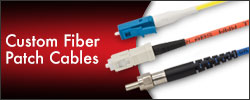



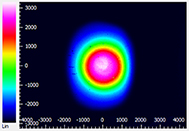

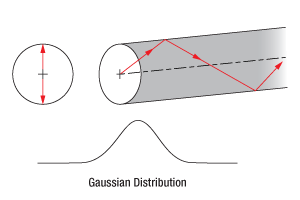
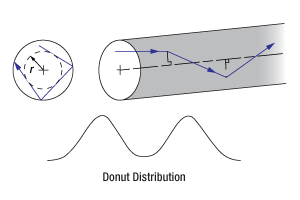
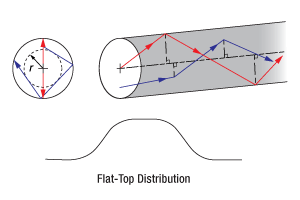
 SMA Step-Index Patch Cables
SMA Step-Index Patch Cables